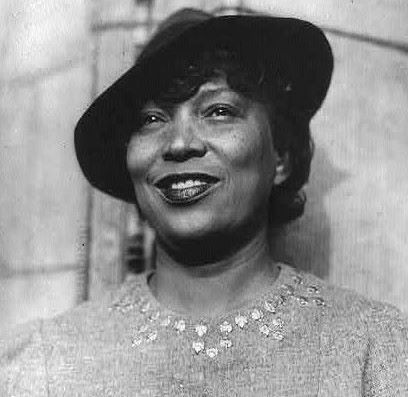Last updated: August 26, 2023
Lesson Plan
Chapter 13 Lesson Plan: The Watsons Go to Birmingham 1963

- Grade Level:
- Middle School: Sixth Grade through Eighth Grade
- Subject:
- Literacy and Language Arts,Social Studies
- Lesson Duration:
- 60 Minutes
Essential Question
How strong is your imagination?
Objective
In this activity, students will learn how Christopher Paul Curtis draws on a rich
African American literary tradition in crafting the "Wool Pooh" imagery.
Preparation
Gather materials:
- Catherine Barnett, "Square Toes and Icy Arms: How to Simplify as You Personify," in Sing the Sun Up: Creative Writing Ideas from African American Literature, ed. Lorenzo Thomas (Teachers and Writers Collaborative,1998), 150-156. (provided)
- Excerpts from Zora Neale Hurston’s Their Eyes Were Watching God (1937) and Dust Tracks on a Road (1942). (provided)
- eBook versions of Zora Neale Hurston’s aforementioned books can be found here:
- Zora Neale Hurston, Their Eyes Were Watching God (Philadelphia, 1937; Ryerson University, February 15, 2022), Their Eyes Were Watching God – Open Textbook (torontomu.ca)
- Zora Neale Hurston, Dust Tracks on a Road: An Autobiography (Philadelphia, 1942; Project Gutenberg, December 22, 2017), Dust Tracks on a Road by Zora Neale Hurston, from Project Gutenberg Canada
Materials
Download Square Toes & Icy Arms, Barnett, 1998
Courtesy of Library of Congress.
Procedure
- Do now: Have students draw the “Wool Pooh,” as described by Kenny in Chapter 13.
- Ask students to share their theories on who (or what) the “Wool Pooh” is.
- When Christopher Paul Curtis wrote Chapter 13 of The Watsons Go to Birmingham—1963, he was thinking about the powerful image of death in Zora Neale Hurston’s work, including in her most famous novel, Their Eyes Were Watching God, and her autobiography, Dust Tracks on a Road. Zora Neale Hurston was an ethnographer who collected Black folklore, in addition to being a novelist, playwright, and filmmaker. Like Langston Hughes, Hurston is a towering figure of the Harlem Renaissance.
- Read aloud two passages in which Zora Neale Hurston personifies death.
- Their Eyes Were Watching God (1937): “Death, that strange being with the huge square toes who lived way in the West. That great one who lived in the straight house like a platform without sides to it, and without a roof. What need has Death for a cover, and what winds can blow against him? He stands in his high house that overlooks the world. Stands watchful and motionless all day with his sword
drawn back...” - Dust Tracks on a Road (1942): “The Master-Maker in His making had made Old Death. Made him with big, soft feet and square toes. Made him with a face that reflects the face of all things, but neither changes itself, nor is mirrored anywhere. Made the body of Death out of infinite hunger. Made a weapon for his hand to satisfy his needs. ... Death had no home and he knew it at once. ... He was already old when he was made. ... Death finished his prowling through the house
on his padded feet and entered the room. He bowed to Mama—."
- Their Eyes Were Watching God (1937): “Death, that strange being with the huge square toes who lived way in the West. That great one who lived in the straight house like a platform without sides to it, and without a roof. What need has Death for a cover, and what winds can blow against him? He stands in his high house that overlooks the world. Stands watchful and motionless all day with his sword
- Tell students both Hurston and Curtis use personification to animate powerful feelings. As poet and scholar Catherine Barnett said, "In a deft 100 words, Hurston manages to give the idea of death a home, gestures, a history, feathers, and flesh."
- Drawing on Barnett’s teaching, ask students to come up with feelings and emotions they hear so often they’ve almost lost their meaning, e.g., love, anger, fear, envy, sadness, exhaustion, potential, perseverance, responsibility, etc. List these words on the whiteboard.
- Have the class choose one emotion, and writing collaboratively, personify it until they reach a consensus. Encourage them to avoid clichés, be specific, include the five senses, and keep it short.
- Have students each select their own word to personify.
- Ask students to evaluate Dr. Martin Luther King Jr.'s "I Have a Dream" speech, and the role personification plays throughout: Transcript of Martin Luther King's 'I Have a Dream' speech : NPR
- Provide students with an emotion to personify.
- Note: Procedure steps four through seven are adapted from Catherine Barnett’s article for teachers, “Square Toes and Icy Arms: How to Simplify as You Personify,” published on PoetryFoundation.org on August 10, 2015.Square Toes and Icy Arms by Catherine Barnett | Poetry Foundation
Vocabulary
Personification: Attributing human characteristics to something nonhuman, or the representation of an abstract quality in human form.
Contact Information
Email us about this lesson plan
Tags: civil rights lesson plans language arts lesson plan social studies lesson plan christopher paul curtis the watsons go to birmingham zora neale hurston their eyes were watching god african american literature middle school middle school lesson plan elementary school elementary school lesson plan civil rights act of 1964
